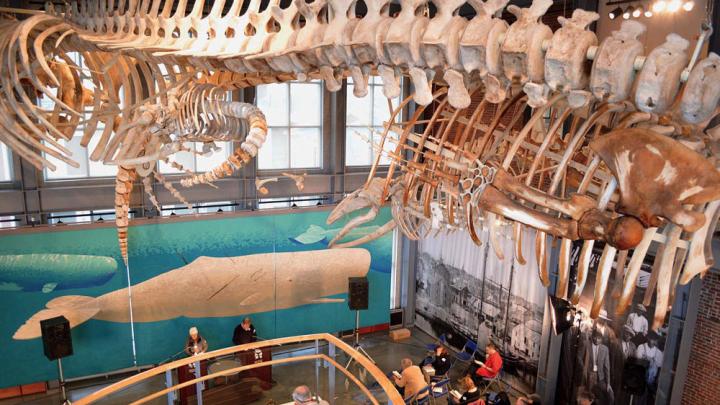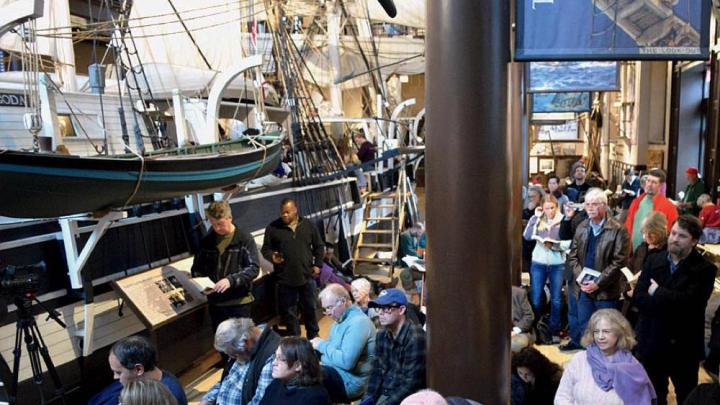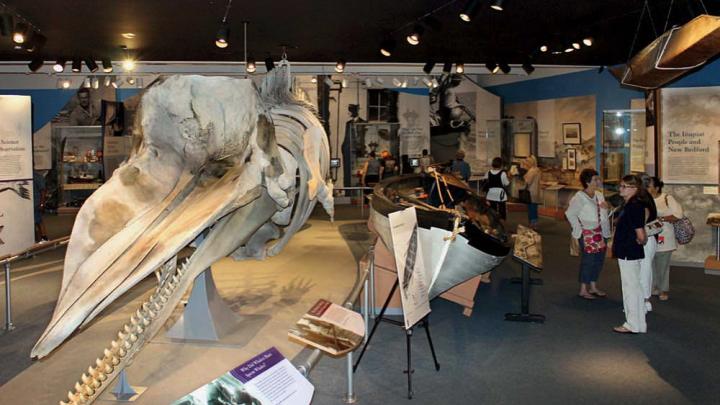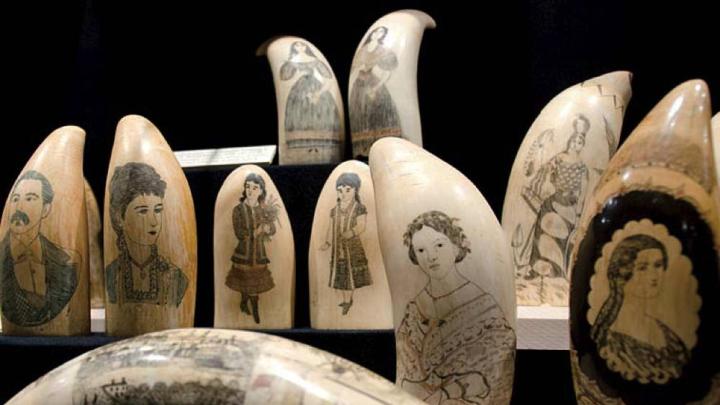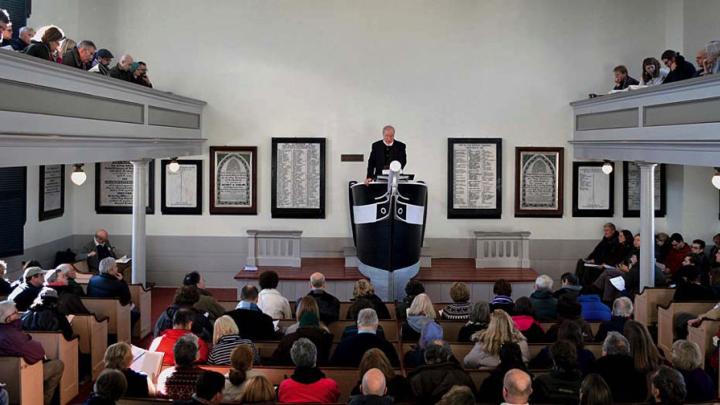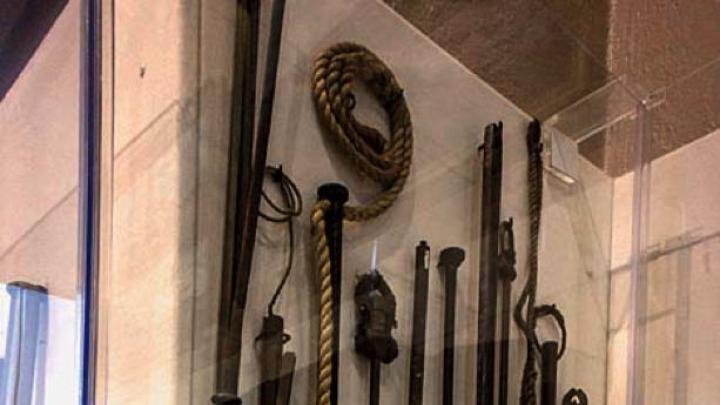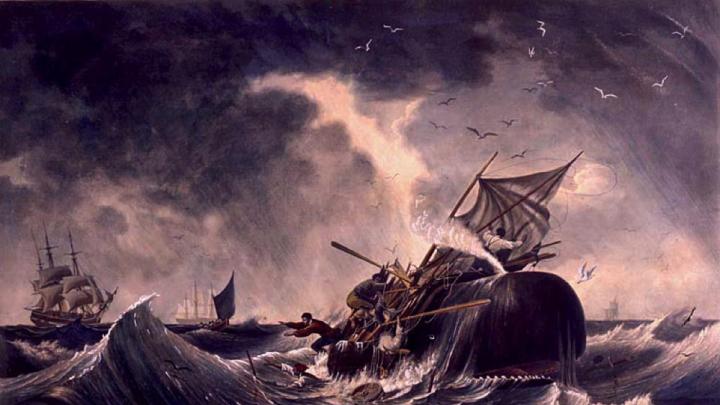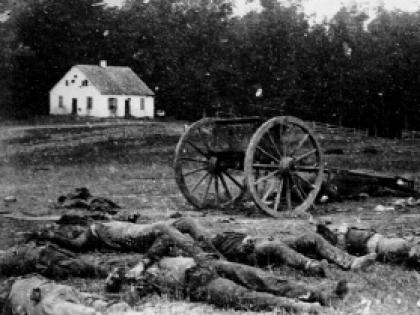At the New Bedford Whaling Museum’s annual Moby-Dick Marathon, all 136 chapters of the great American epic—from “Etymology” to “Epilogue”—are read nonstop, out loud, in a gallery overlooking the harbor. In years past, the reading took place under the sweating bones of Kobo, the rearticulated skeleton of a juvenile blue whale suspended from the ceiling of the Jacobs Family Gallery like a cetacean Sword of Damocles. Kobo (short for “King Of the Blue Ocean”) is one of five whale skeletons the museum has on display, but he is unique. Because his bones weren’t properly prepared, they have, for the past 16 years, wept whale oil, drop by drop, filling the gallery with an anachronistic musk that was ubiquitous in New Bedford 150 years ago.
To smell whale oil today is an uncanny novelty, a means of olfactory time travel possible only in rare places like this museum. It smells of strenuous work and wealth, of a maritime economy responsible for keeping the world lit at night, of a century of environmental hubris; it is the smell of Melville, and it must be experienced in person. By the mid nineteenth century, New Bedford was the whaling capital of the world, responsible for nearly half the global industry. The museum, founded in 1903, is uniquely prepared to inspire the maritime muse, and to illustrate and grapple with its complex history.
The 2017 marathon, itself akin to an epic journey, begins at noon on January 7, and concludes approximately 25 hours later. Starting on November 8, prospective readers can call the museum at 508-717-6851 or sign up online at www.whalingmuseum.org for the opportunity to read for about 10 minutes. (Spots fill up quickly; last year there were 110 people on a waitlist.) One after another after another, about 150 readers take the stage to deliver their allotted share of the story; the group sails along at a flank speed of around 30 pages per hour. For many green hands, this is the first encounter with the great white book. Others, those experienced old tars, have read Moby-Dick more times than they can remember. Anyone is welcome to come and listen to any portion of the marathon; the truly tenacious Ishmaels try to sit and stay awake for the whole voyage.
What is it about this book that entangles so many readers? How has this American epic maintained its steadily growing Rocky Horror-esque cult following of those who insist on a yearly migration to the New Bedford Whaling Museum to ship out, as Ishmael and Melville did nearly two centuries ago, in the dead of winter?
It could be the tight sense of community at the museum. The marathon draws a diverse crew of scholars, students, conservationists, art historians, teachers, scientists, sailors, politicians, musicians, museum professionals, and local residents, all of whom revel in the collective identity that binds them to a book in the lines, sheets, and monkey ropes; each reader demonstrating his or her claim to the title of “aficionado.” One never quite knows who may show up. Even Melville’s great-great-grandchildren, and now great-great-great grandchildren, come to read.
Perhaps it is the challenge of trying to swallow an epic in one big gulp. The book is a notoriously slippery fish, a hodgepodge of literary genres that has, since its publication in 1851, defied categorization and been invoked in an endless myriad of analogies. The casual reader generally sips Moby-Dick, drinking in a few chapters at a time. Marathoners strive to sail the seas of literary endurance. Inevitably, this effort ends with a sudden, sublime perspectival shift of realizing one has been encapsulated by the very thing one was trying to contain, chased by the thing one was pursuing—swallowed whole by the great book.
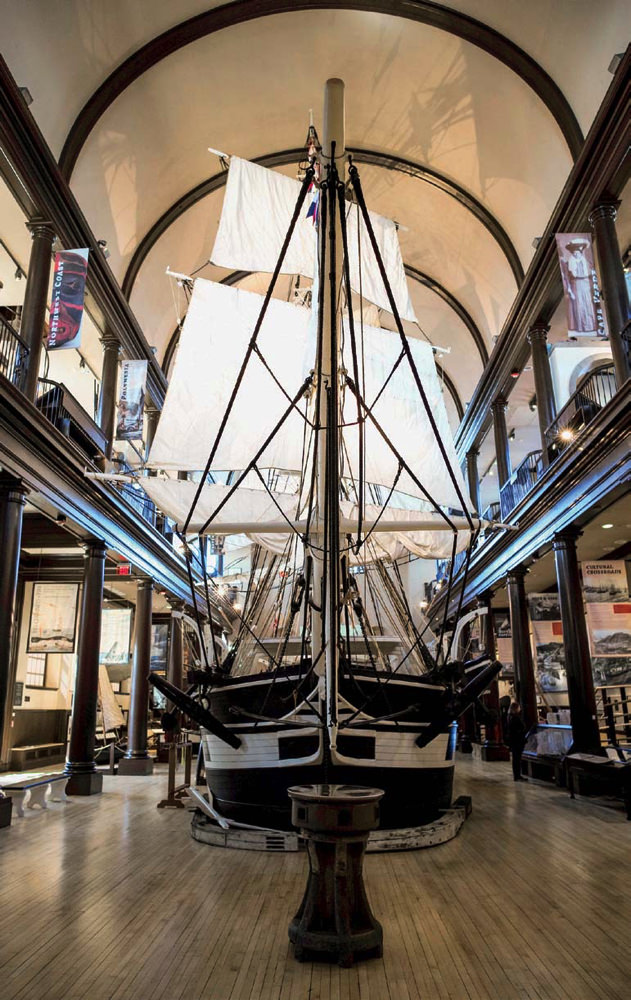
The Lagoda, an 86-foot, half-scale whale-ship model, is the largest of its kind in the world.
Photograh by Danita Delimtont/Alamy Stock Photo
What elevates New Bedford’s Moby-Dick Marathon above all others held around the country is the whaling museum itself, which possesses deep collections of exhibitions and materials unparalleled for the task of illuminating a multisensory, multimedia performance of Melville’s classic. No other marathon audience walks en masse from the galleries to the Seamen’s Bethel across the street, the “Whaleman’s Chapel” described by Melville: “few are the moody fishermen, shortly bound for the Indian Ocean or Pacific, who fail to make a Sunday visit to the spot.” Built in 1832, the chapel is among the many structures that constitute the city’s historic district; its interior walls bear the inscribed names of local whalers and fishermen who have died at sea. There, Father Mapple’s sermon (part of the chapel scenes in chapters seven through nine) is performed live by a selected, talented reader who channels all the fire and brimstone of Jonathan Edwards himself from the bow-shaped pulpit. Marathon readers become one of Mapple’s flock, singing alongside Ishmael “The Ribs and Terrors in the Whale,” the doleful foreshadowing hymn that Melville wrote to accompany the scene. Listeners can even sit in the same pew, according to a label affixed to it, that Melville used when he visited New Bedford.
Another advantage: for readers at the marathon, surrounded by the museum’s collections, whaling jargon is no longer a mystery. Here one can cut through the Gordian knot of vocabulary: sheets, lines, sails, and slang are easily learned aboard the Lagoda, an 86-foot, half-scale whale-ship model, the largest of its kind in the world, which is celebrating its centennial this year. Readers and listeners are free to roam the exhibitions around the Lagoda to see, and in some cases touch, all sorts of harpoons and whalecraft that animate the dangerous business of attempting to kill a 90,000-pound sperm whale with what is, compared to the whale’s bulk, a metal-tipped toothpick. What could possibly compel men to pursue such a mad mission?
What of the whale itself, which Ishmael contemplates time and again? Chapter 32, “Cetology”—notorious for its difficult and lengthy taxonomy of the various species of whales known in the 1850s—is performed with humor and insight with the help of the accompanying permanent exhibition, From Pursuit to Preservation, which corrects Melville’s qualified—but mistaken—assertion that the whale is, in fact, a fish. The exhibition is full of marvelous ecological, biological, and historical information about whales, such as the strange fact that sperm whales do not grow teeth until around 10 years of age, and why they were known as the “carpenter fish,” a fact which provides surprising insight into the ending of Moby-Dick. And then there is the euphemistically titled chapter 95, “The Cassock.” Many an innocent reader has blithely overlooked this digression without realizing that Melville is hilariously describing the whale penis and its many uses. The whaling museum is happy to elaborate on those functions and uses, and, should curiosity strike, visitors might well ask the staff to see the dried penis displayed prudently under the label “grandissimus.”
Then there is the challenge of the ever-growing list of allusions and references Melville makes as the pages turn, which can be matched only by the depth of the museum’s tremendous archive of maritime texts and artifacts—anything Melville read, it has acquired; anything Melville alludes to, it has examples of. Take the bedeviling catalog of art depicting the history of whaling mentioned in chapters 55, 56, and 57: “Of the Monstrous Pictures of Whales”; “Of the Less Erroneous Pictures of Whales”; and “Of Whales in Paint, in Teeth, &C.” During the author’s smorgasbord of obscure art historical references, marathon-goers can meander through the galleries to see some examples of the works themselves—like Pêche du Cachalot, one of several aquatints by Ambroise Louis Garneray, or Baleinier Français en Pêche, a lithograph by Jean-Baptiste Henri Durand-Brager—which Ishmael believed depicted “by far the finest, though in some details not the most correct, presentations of whales and whaling scenes to be anywhere found.”
Participants can also peruse the museum’s collection of every edition of Moby-Dick ever published, and its shelves of scrimshaw: what Melville defines as “lively sketches of whales and whaling-scenes, graven by the fishermen themselves on Sperm Whale-teeth.” Under the aegis of senior curator emeritus Stuart Frank, no fewer than three dictionaries have been published about scrimshaw; a fourth is dedicated solely to the museum’s collection.
Marathoners come as close to the truth of whaling as Melville himself believed was possible without going to sea. The celebratory reading bridges the chasm between a solo, silent reading of Moby-Dick at home, safe and comfortable in one’s own bed, and the multimedia sensorium of the museum. That extends even to the tasting of food. In an often under-examined passage in chapter 15, Melville describes a bowl of New England clam chowder:
Oh, sweet friends! hearken to me. It was made of small juicy clams, scarcely bigger than hazel nuts, mixed with pounded ship biscuit, and salted pork cut up into little flakes; the whole enriched with butter, and plentifully seasoned with pepper and salt.
The passage comes paired with a steaming bowl of hot chowder: metaphor is made material; reading is made reality.
Midnight at the museum is a quieter affair, much like the scene evoked in Chapter 51, “The Spirit-Spout”: through the “serene and moonlight night,” the pages “roll by like scrolls of silver,” under the watch of the skeleton crew of marathoners who keep the ship steady while others sleep.
Fast-forward to the early morning. The sun has risen and those stoic palinuruses who have endured for a whole night approach the finale. The monomania of Ahab and Melville has become their own.
A marathon described cannot compare to a marathon read. For this year, the twenty-first anniversary of the Moby-Dick Marathon (which, coincidentally, is the very age Melville was when he set out on the whaler Acushnet in 1841), the titular question posed in chapter 21 abides:
Going Aboard?
